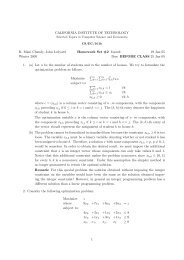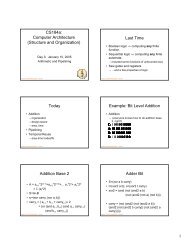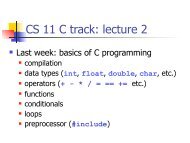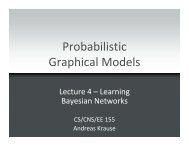Homework 1 Solutions - Caltech
Homework 1 Solutions - Caltech
Homework 1 Solutions - Caltech
Create successful ePaper yourself
Turn your PDF publications into a flip-book with our unique Google optimized e-Paper software.
This ends the proof of the statement. It can now be easily concluded that for any a < 1and for any pair b, q of vectorsz(a · b + (1 − a) · q) ≥ max{z(b), z(q)} ≥ a · z(b) + (1 − a) · z(q) (6)The first part of inequality 6 follows because every feasible solution for z(b) and z(q) isalso a feasible solution for z(a · b + (1 − a) · q) due to the statement. Since a < 1 it iseasy to see that also the second part of the inequality holds.Hence, we have proven that z is a concave function.(b) z is in general nonlinear. In order to convince yourself, consider the function z(b), whereb = (b 1 , b 2 ) is two dimensional vector defined as:z(b) = max −x 2subject to: − x ≤ b 1 , x ≤ b 2Notice that −x 2 is a concave function and the two constraints in the problem are linear(therefore convex).Let b = (−2, 3) and q = (−3, 4). We then have that z(b) = −4 and z(q) = −9. We alsohave that z(b + q) = 25, where b + q = (−5, 7). Therefore z(b + q) ≠ z(b) + z(q) whichmeans that z is nonlinear.(c) The function z is monotonic non decreasing, i.e. if b ≥ q, then z(b) ≥ z(q). If the vectorx maximizes f when the vector of constraints is q (i.e. g j (x) ≤ q j ), then the same vectorx will be a feasible solution for the maximization problem when the vector of constraintsis b (in fact g j (x) ≤ q j ≤ b j ). Hence, z(b) ≥ z(q).2
















